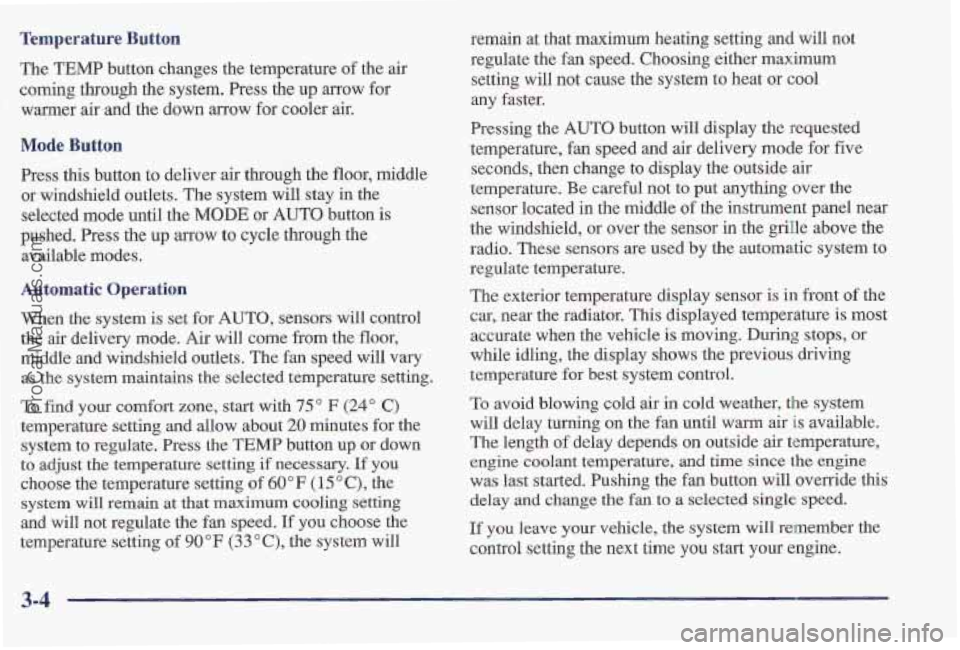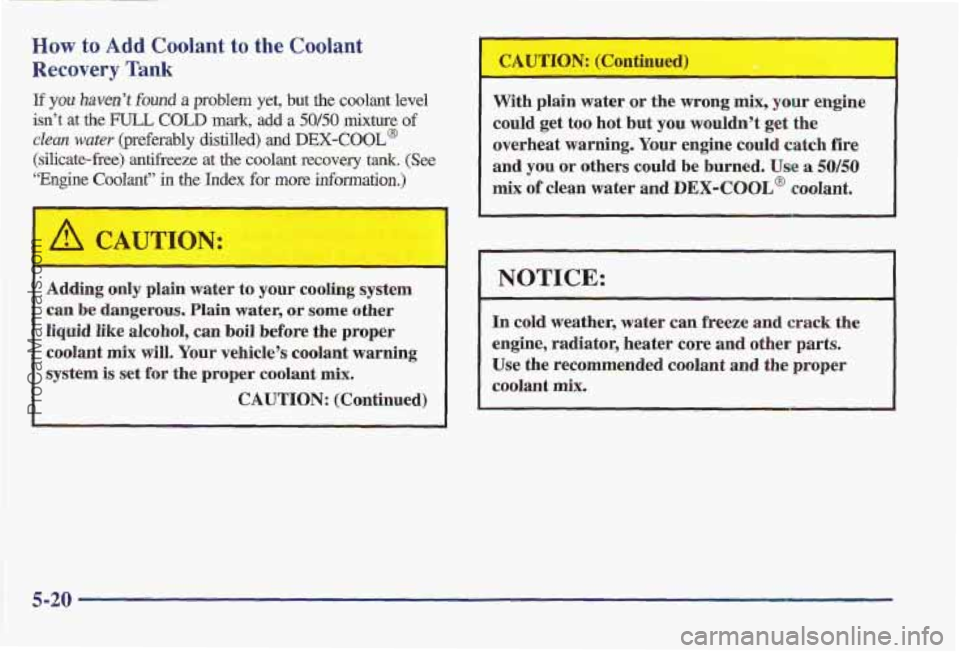Page 145 of 405

Tempmerature Button
The TEMP button changes the temperature of the air
coming
through the system. Press the up arrow for
warmer air-and the down arrow for cooler air.
Mode Button
Press this button to deliver air through the floor, middle
or windshiel'd outlets. The system will stay in the
selected mode until the
MODE or AUTO button is
pushed. Press the up arrow to cycle through the
available modes.
Automatic Operation
When the system is set for AUTO, sensors will control
the air delivery mode. Air will come from the floor,
middle and windshield outlets. The fan speed will vary
as the system maintains the selected temperature setting.
To find your comfort zone, start with 75 O F (24" C)
temperature setting and allow about 20 minutes for the
system to regulate. Press the TEMP button up or down
to adjust the temperature setting if necessary. If you
choose the temperature setting of 60°F (15 O C), the
system
will remain at that maximum cooling setting
and will not regulate the fan speed.
If you choose the
temperature setting
of 90°F (33 "C), the system will remain at that maximum heating setting and will not
regulate the
fan speed. Choosing either maximum
setting will not cause the system to heat or cool
any faster.
Pressing the
AUTO button will display the requested
temperature, fan speed and
air delivery mode for five
seconds, then change to display the outside air
temperature. Be careful not
to put anything over the
sensor located in the middle of the instrument panel near
the windshield, or over the sensor in the grille above the
radio. These sensors are used by the automatic system to
regulate temperature.
The exterior temperature display sensor is in front
of the
car, near the radiator. This displayed temperature is most
accurate when the vehicle is moving. During
stops, or
while idling, the display shows the previous dsaving
temperature
for best system control.
To avoid blowing cold air in cold weather, the system
will delay turning on the fan until warm air
is available.
The length
of delay depends on outside air temperature,
engine coolant temperature,
and time since the engine
was last started. Pushing the fan button will override this
delay and change the fan to a selected single speed.
If you leave your vehicle, the system will remember the
control setting the next time you start your engine.
3-4
ProCarManuals.com
Page 226 of 405
Front Towing (SE)
Attach T-hook chains on
both sides in the slotted
holes in the bottom of
the cradle, behind the
front wheels.
These slots are to be used when using sling-type
equipment
or when loading and securing to
car-carrier equipment.
Position a
4” x 4” wood beam across sling chains
contacting bottom
of the radiator support. Position the
lower sling crossbar directly under the fiont bumper.
5-13
ProCarManuals.com
Page 231 of 405
Cooling System
you’ll see:
When you decide it’s safe to lift the hood, here’s what
A. Coolant Recovery Tank
E. Radiator Pressure Cap
C. Electric Engine Fans
1
’ A CAUTION:
r
An electric fan under the hood can start up even
when the engine
is not running and can injure
you. Keep hands, clothing and tools away from
any underhood electric fan.
If the coolant inside the coolant recovery tank is boiling,
don’t do anything
else until it cools down.
5-18
ProCarManuals.com
Page 232 of 405
The coolant level should be at or above the FULL
COLD mark.
If it isn’t, you may have a leak in the radiator hoses,
heater hoses, radiator, water
pump or somewhere else in
the cooling system. Heater and radiator
hoses, and other engine
parts, can be
very hot. Don’t touch them. If you
do, you can be burned.
Don’t run the engine if there is
a leak. If you run
the engine, it could lose all coolant. That could
cause an engine fire, and you could be burned.
Get any leak fixed before you drive the vehicle.
I NOTICE: I
Engine damage from running your engine
without coolant isn’t covered by your warranty.
If there seems to
be no leak, with the engine on, check to
see if the electric engine fans are running. If the engine
is overheating, both
fans should be running. If they
aren’t, your vehicle needs service.
5-19
ProCarManuals.com
Page 233 of 405

How to Add Coolant to the Coolant
Recovery Tank
If you haven’t found a problem yet, but the coolant level
isn’t
at the FULL COLD mark, add a 50/50 mixture of
clean water (preferably distilled) and DEX-COOL@
(silicate-free) antifreeze at the coolant recovery tank. (See
“Engine Coolant” in the Index for more information.)
With plain water or the wrong mix, your engine
could get too hot but
you wouldn’t get the
overheat warning.
Your engine could catch fire
and you or others could be burned. Use a 50/58
mix of clean water and DEX-COOL@ coolant.
r--- Adding only plain water to your cooling system 1 c NOTICE:
can be dangerous. Plain water, or some o’ther
liquid like alcohol,
can boil before the proper
coolant mix will. Your vehicle’s coolant warning
system is set for the proper coolant mix,
In cold weather, water can freeze and crack the
engine, radiator, heater core and other
parts.
Use
the recommended coolant and the proper
coolant mix.
CAUTION: (Continued)
5-20
ProCarManuals.com
Page 234 of 405
You can be burned if you spill coolant on hot
engine parts. Coolant contains ethylene
glycol
and it will burn if the engine parts are hot
enough. Don’t spill coolant on a hot engine.
L
When the coolant in the coolant recovery tank is at the
FULL COLD mark, start your vehicle.
If the overheat warning continues, there’s one more
thing
you can try. You can add the proper coolant mix
directly to the radiator, but be sure the cooling system is
cool before you do it.
5-21
ProCarManuals.com
Page 235 of 405
~ Steam and scalding
liquids from a hot cooling
system can
blow out and burn you badly. They
are under pressure, and if
you turn the radiator
pressure
cap -- even a little -- they can come out
at high speed. Never turn the cap when the
cooling system, including the radiator pressure
cap,
is hot. Wait for the cooling system and
radiator pressure
cap to cool if you ever have to
turn
the pressure cap.
5-22
ProCarManuals.com
Page 236 of 405
How to Add Coolant to the Radiator
2. Then keep turning the pressure cap, but now push
down as you turn it. Remove the pressure cap.
1. You can remove the radiator pressure cap when the
cooling system, including the radiator pressure cap
and upper radiator
hose, is no longer hot. Turn the
pressure cap
slowly counterclockwise until it first
stops.
(Don’t press down while turning the
pressure cap.)
If you hear a hiss, wait for that to stop. A hiss means
there is still some pressure left.
5-23
ProCarManuals.com